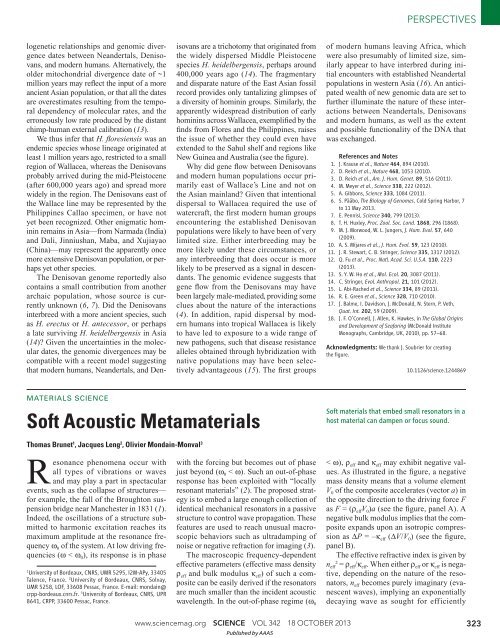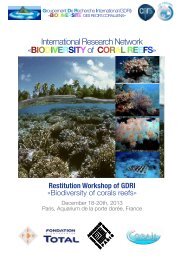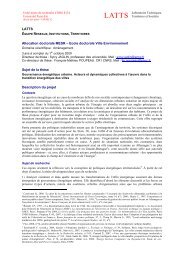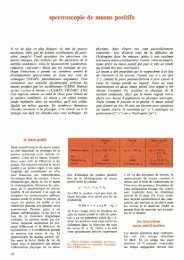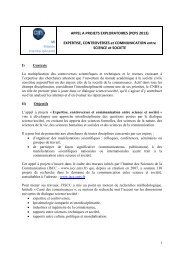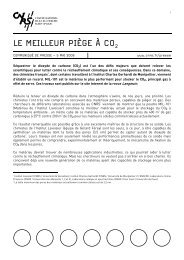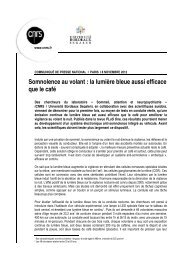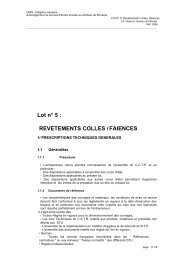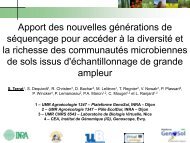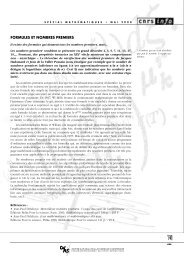Soft Acoustic Metamaterials - CNRS
Soft Acoustic Metamaterials - CNRS
Soft Acoustic Metamaterials - CNRS
You also want an ePaper? Increase the reach of your titles
YUMPU automatically turns print PDFs into web optimized ePapers that Google loves.
PERSPECTIVES<br />
logenetic relationships and genomic divergence<br />
dates between Neandertals, Denisovans,<br />
and modern humans. Alternatively, the<br />
older mitochondrial divergence date of ~1<br />
million years may reflect the input of a more<br />
ancient Asian population, or that all the dates<br />
are overestimates resulting from the temporal<br />
dependency of molecular rates, and the<br />
erroneously low rate produced by the distant<br />
chimp-human external calibration ( 13).<br />
We thus infer that H. fl oresiensis was an<br />
endemic species whose lineage originated at<br />
least 1 million years ago, restricted to a small<br />
region of Wallacea, whereas the Denisovans<br />
probably arrived during the mid-Pleistocene<br />
(after 600,000 years ago) and spread more<br />
widely in the region. The Denisovans east of<br />
the Wallace line may be represented by the<br />
Philippines Callao specimen, or have not<br />
yet been recognized. Other enigmatic hominin<br />
remains in Asia—from Narmada (India)<br />
and Dali, Jinniushan, Maba, and Xujiayao<br />
(China)—may represent the apparently once<br />
more extensive Denisovan population, or perhaps<br />
yet other species.<br />
The Denisovan genome reportedly also<br />
contains a small contribution from another<br />
archaic population, whose source is currently<br />
unknown ( 6, 7). Did the Denisovans<br />
interbreed with a more ancient species, such<br />
as H. erectus or H. antecessor, or perhaps<br />
a late surviving H. heidelbergensis in Asia<br />
( 14)? Given the uncertainties in the molecular<br />
dates, the genomic divergences may be<br />
compatible with a recent model suggesting<br />
that modern humans, Neandertals, and Denisovans<br />
are a trichotomy that originated from<br />
the widely dispersed Middle Pleistocene<br />
species H. heidelbergensis, perhaps around<br />
400,000 years ago ( 14). The fragmentary<br />
and disparate nature of the East Asian fossil<br />
record provides only tantalizing glimpses of<br />
a diversity of hominin groups. Similarly, the<br />
apparently widespread distribution of early<br />
hominins across Wallacea, exemplified by the<br />
finds from Flores and the Philippines, raises<br />
the issue of whether they could even have<br />
extended to the Sahul shelf and regions like<br />
New Guinea and Australia (see the figure).<br />
Why did gene flow between Denisovans<br />
and modern human populations occur primarily<br />
east of Wallace’s Line and not on<br />
the Asian mainland? Given that intentional<br />
dispersal to Wallacea required the use of<br />
watercraft, the first modern human groups<br />
encountering the established Denisovan<br />
populations were likely to have been of very<br />
limited size. Either interbreeding may be<br />
more likely under these circumstances, or<br />
any interbreeding that does occur is more<br />
likely to be preserved as a signal in descendants.<br />
The genomic evidence suggests that<br />
gene flow from the Denisovans may have<br />
been largely male-mediated, providing some<br />
clues about the nature of the interactions<br />
( 4). In addition, rapid dispersal by modern<br />
humans into tropical Wallacea is likely<br />
to have led to exposure to a wide range of<br />
new pathogens, such that disease resistance<br />
alleles obtained through hybridization with<br />
native populations may have been selectively<br />
advantageous ( 15). The first groups<br />
of modern humans leaving Africa, which<br />
were also presumably of limited size, similarly<br />
appear to have interbred during initial<br />
encounters with established Neandertal<br />
populations in western Asia ( 16). An anticipated<br />
wealth of new genomic data are set to<br />
further illuminate the nature of these interactions<br />
between Neandertals, Denisovans<br />
and modern humans, as well as the extent<br />
and possible functionality of the DNA that<br />
was exchanged.<br />
References and Notes<br />
1. J. Krause et al., Nature 464, 894 (2010).<br />
2. D. Reich et al., Nature 468, 1053 (2010).<br />
3. D. Reich et al., Am. J. Hum. Genet. 89, 516 (2011).<br />
4. M. Meyer et al., Science 338, 222 (2012).<br />
5. A. Gibbons, Science 333, 1084 (2011).<br />
6. S. Pääbo, The Biology of Genomes, Cold Spring Harbor, 7<br />
to 11 May 2013.<br />
7. E. Pennisi, Science 340, 799 (2013).<br />
8. T. H. Huxley, Proc. Zool. Soc. Lond. 1868, 296 (1868).<br />
9. M. J. Morwood, W. L. Jungers, J. Hum. Evol. 57, 640<br />
(2009).<br />
10. A. S. Mijares et al., J. Hum. Evol. 59, 123 (2010).<br />
11. J. R. Stewart, C. B. Stringer, Science 335, 1317 (2012).<br />
12. Q. Fu et al., Proc. Natl. Acad. Sci. U.S.A. 110, 2223<br />
(2013).<br />
13. S. Y. W. Ho et al., Mol. Ecol. 20, 3087 (2011).<br />
14. C. Stringer, Evol. Anthropol. 21, 101 (2012).<br />
15. L. Abi-Rached et al., Science 334, 89 (2011).<br />
16. R. E. Green et al., Science 328, 710 (2010).<br />
17. J. Balme, I. Davidson, J. McDonald, N. Stern, P. Veth,<br />
Quat. Int. 202, 59 (2009).<br />
18. J. F. O’Connell, J. Allen, K. Hawkes, in The Global Origins<br />
and Development of Seafaring (McDonald Institute<br />
Monographs, Cambridge, UK, 2010), pp. 57–68.<br />
Acknowledgments: We thank J. Soubrier for creating<br />
the figure.<br />
10.1126/science.1244869<br />
MATERIALS SCIENCE<br />
<strong>Soft</strong> <strong>Acoustic</strong> <strong>Metamaterials</strong><br />
<strong>Soft</strong> materials that embed small resonators in a<br />
host material can dampen or focus sound.<br />
Thomas Brunet 1 , Jacques Leng 2 , Olivier Mondain-Monval 3<br />
Resonance phenomena occur with<br />
all types of vibrations or waves<br />
and may play a part in spectacular<br />
events, such as the collapse of structures—<br />
for example, the fall of the Broughton suspension<br />
bridge near Manchester in 1831 ( 1).<br />
Indeed, the oscillations of a structure submitted<br />
to harmonic excitation reaches its<br />
maximum amplitude at the resonance frequency<br />
ω 0 of the system. At low driving frequencies<br />
(ω < ω 0 ), its response is in phase<br />
1<br />
University of Bordeaux, <strong>CNRS</strong>, UMR 5295, I2M-APy, 33405<br />
Talence, France. 2 University of Bordeaux, <strong>CNRS</strong>, Solvay,<br />
UMR 5258, LOF, 33608 Pessac, France. E-mail: mondain@<br />
crpp-bordeaux.cnrs.fr. 3 University of Bordeaux, <strong>CNRS</strong>, UPR<br />
8641, CRPP, 33600 Pessac, France.<br />
with the forcing but becomes out of phase<br />
just beyond (ω 0 < ω). Such an out-of-phase<br />
response has been exploited with “locally<br />
resonant materials” ( 2). The proposed strategy<br />
is to embed a large enough collection of<br />
identical mechanical resonators in a passive<br />
structure to control wave propagation. These<br />
features are used to reach unusual macroscopic<br />
behaviors such as ultradamping of<br />
noise or negative refraction for imaging ( 3).<br />
The macroscopic frequency-dependent<br />
effective parameters (effective mass density<br />
ρ eff and bulk modulus κ eff ) of such a composite<br />
can be easily derived if the resonators<br />
are much smaller than the incident acoustic<br />
wavelength. In the out-of-phase regime (ω 0<br />
< ω), ρ eff and κ eff may exhibit negative values.<br />
As illustrated in the figure, a negative<br />
mass density means that a volume element<br />
V 0 of the composite accelerates (vector a) in<br />
the opposite direction to the driving force F<br />
as F = (ρ eff V 0 )a (see the figure, panel A). A<br />
negative bulk modulus implies that the composite<br />
expands upon an isotropic compression<br />
as ∆P = –κ eff (∆V/V 0 ) (see the figure,<br />
panel B).<br />
The effective refractive index is given by<br />
n eff<br />
2<br />
= ρ eff /κ eff . When either ρ eff or κ eff is negative,<br />
depending on the nature of the resonators,<br />
n eff becomes purely imaginary (evanescent<br />
waves), implying an exponentially<br />
decaying wave as sought for efficiently<br />
www.sciencemag.org SCIENCE VOL 342 18 OCTOBER 2013 323<br />
Published by AAAS


